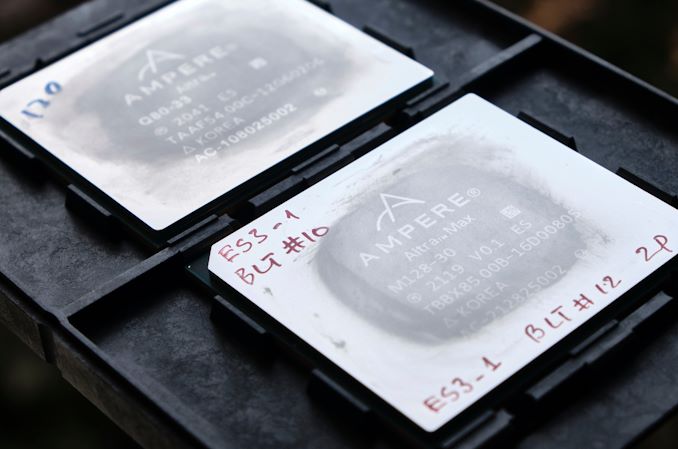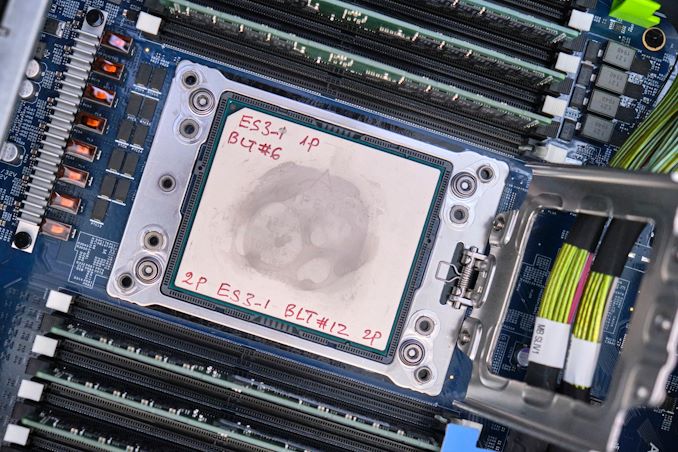The Ampere Altra Max Review: Pushing it to 128 Cores per Socket
by Andrei Frumusanu on October 7, 2021 8:00 AM EST- Posted in
- Servers
- Arm
- Neoverse N1
- Ampere
- Altra Max

It’s been a little over a year since Ampere started to deliver their first generation Altra processors. The “Quicksilver” design with 80 Neoverse N1 cores was the first merchant Arm silicon on the market who really went “all-out” in terms of performance targets, aiming for the best of what AMD and Intel had to offer, ending up in a very competitive standing against the newest EPYC CPUs and leapfrogging Intel’s offerings.
Since that first review, the competition has released two new generation platforms, the newer EPYC Milan chips, showcasing a good generational boost, and Intel dramatically narrowing the performance gap with the new Ice Lake-SP Xeon parts.
Related Reading:
-
The Ampere Altra Review: 2x 80 Cores Arm Server Performance Monster
-
AMD EPYC Milan Review Part 2: Testing 8 to 64 Cores in a Production Platform
-
AMD 3rd Gen EPYC Milan Review: A Peak vs Per Core Performance Balance
-
Intel 3rd Gen Xeon Scalable (Ice Lake SP) Review: Generationally Big, Competitively Small
For the Arm ecosystem and Ampere in particular, things naturally also aren’t standing still; following the first-gen 80-core Quicksilver design, we had long expected the 128-core “Mystique” Altra Max design. Arguably a bit late compared to Ampere’s initial Q4 2020 projections, we’ve now finally had our hands on the new many-core monster for today’s initial review.
Pushing it to 128 Cores
The new Altra Max is a quite exciting part, but it’s also relatively straightforward design compared to the original Altra parts. While the original chip had been pushing 80 Neoverse-N1 cores, the new Altra Max is pushing 128 cores. While there are also slightly improved technical differences between the two chip generations, that is mostly the main large differentiation between the two designs.
Ampere is still continuing to offer both Altra and Altra Max chips in their product line-up, with the Max parts in particular filling the high-core count SKU segment:
| Ampere Altra SKU List | ||||||
| AnandTech | Cores | Frequency | TDP | PCIe | DDR4 | Price |
| Altra Max "Mystique" | ||||||
| M128-30 (Tested) |
128 | 3.0 GHz | 250 W | 128x G4 | 8 x 3200 | $5800 |
| M128-28 | 128 | 2.8 GHz | 230 W | 128x G4 | 8 x 3200 | $5500 |
| M128-26 | 128 | 2.6 GHz | 190 W | 128x G4 | 8 x 3200 | $5400 |
| M112-30 | 112 | 3.0 GHz | 240 W | 128x G4 | 8 x 3200 | $5100 |
| M96-30 | 96 | 3.0 GHz | 220 W | 128x G4 | 8 x 3200 | $4550 |
| M96-28 | 96 | 2.8 GHz | 190 W | 128x G4 | 8 x 3200 | $4250 |
| Altra "Quicksilver" | ||||||
| Q80-33 (Tested) |
80 | 3.3 GHz | 250 W | 128x G4 | 8 x 3200 | $4050 |
| Q80-30 | 80 | 3.0 GHz | 210 W | 128x G4 | 8 x 3200 | $3950 |
| Q80-26 | 80 | 2.6 GHz | 175 W | 128x G4 | 8 x 3200 | $3810 |
| Q72-30 | 72 | 3.0 GHz | 195 W | 128x G4 | 8 x 3200 | $3590 |
| Q64-33 | 64 | 3.3 GHz | 220 W | 128x G4 | 8 x 3200 | $3810 |
| Q64-30 | 64 | 3.0 GHz | 180 W | 128x G4 | 8 x 3200 | $3480 |
| Q64-26 | 64 | 2.6 GHz | 125 W | 128x G4 | 8 x 3200 | $3260 |
| Q64-24 | 64 | 2.4 GHz | 95 W | 128x G4 | 8 x 3200 | $3090 |
| Q32-17 | 32 | 1.7 GHz | 45 W | 128x G4 | 8 x 3200 | $800 |
The unit we’re testing today, the flagship Altra Max M128-30, with 128 cores and a 3.0GHz clock (again, noteworthy congratulations of Ampere’s straightforward and descriptive part naming), with a maximum TDP of 250W.
Much like the first-generation parts, platform side features are all identical throughout the product stack, always featuring the maximum 128 lanes of PCIe 4.0 and 8-channel DDR4-3200 capabilities.
Comparing the M128-30 to the Q80-33, the new Altra Max part is able to fit in 60% more cores, albeit at 10% lower frequency, within the same advertised TDP. It’s to be noted that TDP here doesn’t mean power consumption, and in our initial review of the Q80-33 we noted that the chip in many workloads hovered at power levels much below the TDP, possibly explaining why and Ampere was able to grow the core count this much even though the chip isn’t on a fundamentally different process node (TSMC N7), though it’s on a better implementation.
The SKU list for the new Altra Max parts is interesting in that there’s only parts from 96 cores onwards, with anything below that still being serviced by the original Altra SKUs. It’s very likely that due to the process node maturity of the N7 node that Ampere here likely has few chips yielding with fewer cores, and the higher clocks and larger cache of the Quicksilver chips would be better served for lower core count deployments anyhow.
In terms of pricing, Ampere is quite aggressive, vastly undercutting both AMD and Intel’s flagship parts MSRPs, though as always, what large customers and hyperscalers pay are most of the time never in line with those prices anyhow – but it’s still a large win for Ampere in terms of visible pricing.
The Altra Max is extremely straightforward in terms of deployment: following some initial required firmware updates, it’s essentially a drop-in solution on the existing Altra platforms, which is exactly what we did for our review, re-using the original Mount Jade reference server from Wiwynn. The only practical note to make here is that at time of writing, Ampere currently doesn’t have a dual capable firmware stack that would enable swapping around from Altra to Altra Max and vice-versa, our initial setup was a one-way upgrade, with interoperability firmware still being something in the works for the future.












60 Comments
View All Comments
lemurbutton - Thursday, October 7, 2021 - link
Before AMD can disrupt Intel in the server, Ampere has disrupted AMD. And now Intel is coming back with Saphire Rapids. Doesn't look good for AMD.Teckk - Thursday, October 7, 2021 - link
AMD also has upcoming products, same as other companies :) Competition is good.schujj07 - Thursday, October 7, 2021 - link
Most likely Sapphire Rapids will only get Intel to Epyc Milan or a little past there. Overall ICL Xeon only caught Intel up to Epyc Rome. Initial tests on Milan were good, showing 5-7% better performance which isn't bad, however, it wasn't like what we saw on the desktop side. Turns out the benchmarks were run on a reference platform that AMD hacked to allow 3rd Gen support. Once benchmarks were done on Milan on platforms designed for 3rd Gen the performance jumped by another 10% or more. Basically that put ICL 15-17% behind Epyc Milan and SPR is only supposed to get about 19% more performance.mode_13h - Thursday, October 7, 2021 - link
> Initial tests on Milan were good, showing 5-7% better performance which isn't badInitial tests were flawed, due to non-production hardware/firmware. Check out their update:
https://www.anandtech.com/show/16778/amd-epyc-mila...
schujj07 - Thursday, October 7, 2021 - link
"Initial tests were flawed, due to non-production hardware/firmware."I basically said that in my initial comment.
"Turns out the benchmarks were run on a reference platform that AMD hacked to allow 3rd Gen support. Once benchmarks were done on Milan on platforms designed for 3rd Gen the performance jumped by another 10% or more. "
GreenReaper - Saturday, October 9, 2021 - link
Your initial comment was too long, he didn't read that far before hitting reply.whatthe123 - Thursday, October 7, 2021 - link
icelake is not great in general. it was an improvement over 14nm but the core scaling was not there and their 10nm was still struggling to hit competitive boost clocks. I don't think the uplift they saw between 14nm and icelake reflects sapphire rapids at all considering the major design changes and improved node, but if it does I don't see how sapphire rapids would compete with milan at a lower core count. If its competing with milan then the per-core performance and MT scaling has seen a huge uplift compared to icelake.schujj07 - Thursday, October 7, 2021 - link
Had ICL come out on time people would have been more impressed. The problem that ICL has is since it was soooooo late Intel had to squeeze every ounce of performance out of SKL. Overall ICL is just a short term platform but the performance comparison to SPR.mode_13h - Friday, October 8, 2021 - link
> Had ICL come out on time people would have been more impressed.Depends on what you mean by "on time". If it had come in place of Cascade Lake, then probably. However, if it still followed Cascade Lake, then the clockspeed drop and strong competition from Rome & comparison with Graviton 2 are still unflattering.
If Ice Lake had notched up the clockspeed ladder *and* launched in place of Cascade Lake, then it would've been a very solid entry.
Anyway, I'm sure Intel is still selling every one they can make. People are quick to point out how AMD benefited from Intel's process woes, but the past 5 years' demand surge has provided Intel a very nice cushion. They basically couldn't have picked a better time to falter.
schujj07 - Friday, October 8, 2021 - link
I believe that ICL was supposed to be 2nd Gen Scalable. When Intel found that it wasn't ready, they released Cascade Lake. Even worse was needing to release Cooper Lake for 4-8S systems in 2H 2020.